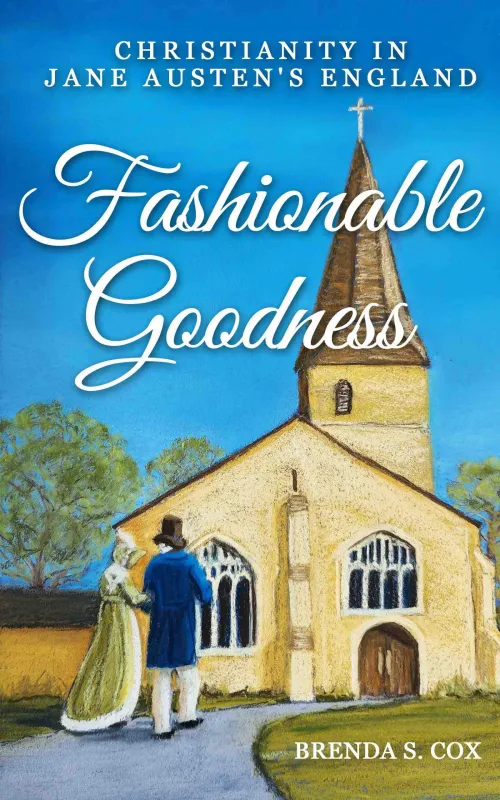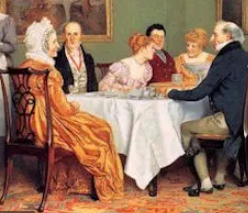The old adage that if one must ask for the price of an item, one most likely cannot afford it probably holds true for the lovely furniture for sale in Chappell & McCullar, a fine antique shop. I found several pieces of interest on their website, including a pair of Regency ebonized and parcel-gilt open arm chairs, a lush Regency giltwood and ebonized mirror c. 1820, and this charming rosewood tea caddy. But, ahem, there was no price affixed, and one must take the additional step of contacting the owner to inquire about its cost.Tea was such a precious commodity after its introduction in England during the mid 17th century, that servants were never entrusted with handling the loose leaves. Green and black tea leaves were imported in large chests, from which the loose leaves were measured. The tea was then stored in the customer’s caddy, or cannister, which came with a lock and key to prevent pilfering. According to Miller’s Antique Encyclopedia, caddy is a word derived from ‘kati’, a Malay standard weight of tea.By 1800, the custom of drinking tea in England was almost 150 years old. The first written record on English shores was in Samuel Pepys’ dairy, in an entry written on September 25, 1660, in which he wrote:
To the office, where Sir W Batten, Collonel Slingsby, and I sat a while; … And afterwards did send for a Cupp of Tee (a China drink) of which I never had drank before) and went away.
The brew’s popularity soared quickly. Overseas trade in the East Indies flourished, and missionaries in China wrote home about tea’s healing powers. It was widely thought that tea could treat gout, as well as restore one’s mental powers. The brew was relatively safe in an era of contaminated water, since the hot beverage required that water be boiled first.In 1717 Thomas Twining turned his coffee house into a tea shop, and in 1784, Richard Twining, chairman of the tea dealers’ guild, persuaded the government to reduce the import tax on tea, making it much more affordable. By the 1800’s tea was widely drunk by the middle classes. One can imagine that in an era when gin was cheap and led to the ruination of the lower classes, drinking tea was regarded a more wholesome activity.However, tea remained expensive. The British East India Company, which held the monopoly on importing tea until 1834, held prices artificially high for centuries. In addition, the government kept raising taxes on tea in order to finance England’s expensive wars. Smuggling tea became a lucrative business, and shopkeepers and individuals were not averse to purchasing tea leaves on the black market. Be that as it may, by Jane Austen’s day, the drinking of tea had become a regular occurrence, both at home and in public. In a letter to Cassandra, Jane Austen writes of drinking tea at the Public Assembly Rooms in Bath:
Before tea it was rather a dull affair; but then the before tea did not last long, for there was only one dance, danced by four couple. Think of four couple, surrounded by about an hundred people, dancing in the Upper Rooms at Bath. – Jane Austen, May 12, 1801
Although tea was served at home by the hostess, who held the key to the caddy, the elaborate ceremony of afternoon tea, or the custom of serving tea with cakes, scones, and crumpets to stave off hunger pangs before dinner, was not invented until 1840 by the 7th Duchess of Bedford.Interesting tea facts:
- “Taking tea” is a vulgar expression. Drinking tea is considered the proper phrase.
- High tea consisted of a full, dinner meal for the common people. Tea was still served, but there would also be meats, fish or eggs, cheese, bread and butter, and cake. It was more of a man’s meal, than a ladies social diversion.
Read more about the fascinating history of tea and tea caddies at these sites:
- On the Tea Table: The Georgian Index
- Antique boxes in English Society: Tea Caddies and Tea
- Miller’s Antiques Encyclopedia
- The Blissborne Tea Library
Technorati Tags: Tea, History of Tea, Tea in the Regency Era, Jane Austen, British East India Company, Afternoon Tea








Excellent post, I love tea, usually about 4 pm, with sugar and milk please.
[…] Tea in the Regency Era […]
DOES ANYONE KNOW THE LIGHT-GREEN CHINA PATTERN THAT WAS USED BY THE BENNETT FAMILY IN THE MASTERPIECE SERIES OF “PRIDE AND PREJUDICE?”
WARMEST AND KINDEST REGARDS,
SHERRY
I am also trying to identify the china pattern used by the Bennett family in the 1995 BBC production of Pride and Prejudice. I do know the pattern used by the Bingleys was Royal Doulton English Renaissance, but I cannot yet identify what was used in the Longbourn dining scenes.
Thanks you to anyone who can help,
Marcia
I think I found the Bennett family china pattern. I believe it is Cornelia-Green by Mottahedeh. This pattern also comes in blue. A few pieces are available from Replacements Ltd., and I have had very good service from them in the past.
Marcia
Marcia: I created a post with some images of the Cornelia-Green pattern. (Click on link.) Thank you for finding it. Vic
[…] of P&P 95. J.A.W. visitor Marcia Larson found the Cornelia Green pattern by Mottahedeh (See comment in this post). Examining the photos of the china in the dining scene with the pattern that Marcia found – look […]
THANKS FOR FINDING THIS LOVELY PATTERN. YOU’VE ALL BEEN TERRIFIC!
WARMEST AND KINDEST REGARDS,
SHERRY
Please can anyone tell me the name of the ‘best’ china tea service used in the Bennet household? (BBC adaptation of Pride and Prejudice.)
It appears in the scene after Lydia has been invited to Brighton and the Officers are taking tea at the Bennet’s. Elizabeth is standing in front of a cabinet which seems to contain the whole service and there is a close up of the cup from which she is drinking. It has a white background with lilac and pink flowers and a gold rim.
I’ve noticed it in other BBC period dramas too.
Any suggestions?
Thanks very much.
Corrina
[…] In 1840, the Duchess of Bedford began serving tea with refreshments in the afternoon to appease her appetite before dinner. To read more about drinking tea between the 18th century and mid-19th century, read my post about Tea in the Regency Era. […]
Can you please, possibly identify the rococco china tea service that Lionel Logue had set up, for the Queen Mum, in the film, “The King’s Speech” ?
Also, his small green pottery tea pot, with the snubbed spout. It is on a table next to the seated King (Oscar- nominated Colin Firth) in Lionel Logue’s consultory room.
Many thanks.
I’ll ask people on Facebook and Twitter! Vic
Where did you find the photo of the tea caddy? I would like to use it for a lesson plan I’m working on about tea. Thank you!
[…] Tea in the Regency […]